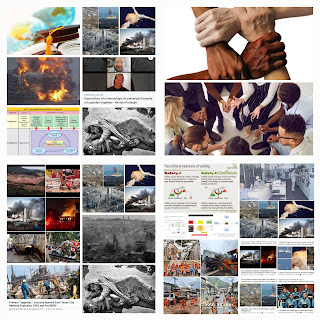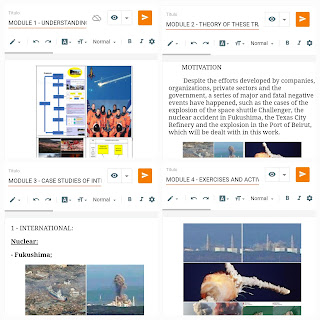Human Error is the tip of the iceberg, it is what initially appears in major and fatal negative events, it is important to understand the relevance of exogenous and endogenous variables in the systemically structured sociotechnical system.
Focus on the Structured Sociotechnical System and not on Human Error.
Proactive Safety Principle.
What do you think?
Contributions?
The sociotechnical approach is divided into organizational, human, and technological factors, which I define as endogenous variables.
As a contribution to this proposal for a sociotechnical approach, I present, based on the case studies research for this work, major and fatal negative events, at the international, national, and local levels, a proposition of the structured sociotechnical approach, where they are included in this analysis are the contributors: social, economic and other requirements; norms and legislation at the World, Country, State, Municipality and Sector levels, which I define as exogenous variables. As a result of the interaction between exogenous and endogenous variables, positive and negative events will occur, which will be shown in Figure 1.
Figure 1 - Structural Sociotechnical Approach
The Exogenous Variables are the contributors to the event, external to the organization, a possible classification of level can be at the World, Country, State, Municipality, Sectors, and others, as examples, we can highlight international, national, sectorial, state, municipal standards of security, the economic requirements of recession and economic growth, events of nature, and other variables, which were not verified in the case studies analyzed in Barbosa (2022), such as terrorism, sabotage, theft, and vandalism, among others, present in other unanalyzed negative events.
The Endogenous Variables are the Organizational, Human and Technological Factors.
The Organizational Factors are related to the actions of the Senior Management, Administrative Council, Management, Senior Management, and Advisory/Staff, these functions are in the corporate instance, as an example of actions of this factor are: the definition of investments, corporate procedures and the decisions that affect the area of operations of the organization, pressures for profitability, continuity, and discontinuity of the business Organizational Factors are constitutive elements for Human and Technological Factors issues, an adequate analysis of the organization's risks and emergencies is of vital importance for the prevention of major negative events, and for the success and continuity of the Organization's operations.
The Human Factors are related to the actions of technicians, supervisors, and middle management who work in the operation of the company's activity; as an example of a hierarchical level we can exemplify the case of an oil rig manager, director of a mining company's site and a supervisor of a manufacturing line; cases related to fatigue, stress, and pressure for results are issued to be analyzed in this factor.
The Technological Factors are related to the entire infrastructure for the company's operation, they are the machines, equipment, software, and production and support facilities; equipment failures are related to this factor.
Human Error is the tip of the iceberg, it is what initially appears in major and fatal negative events, it is important to understand the relevance of exogenous and endogenous variables in the systemically structured socio-technical system.
“Focus on the Structured Sociotechnical System and not on Human Error”.
First Principle of Proactive Safety.
For more information, videos, and complementary materials, about Safety, access the link at the end of this post.
Are we paying attention to the essential issues for the Safety of Organizations?
How many lives, what social, environmental, patrimonial impact, in the image of the organization and others, would be spared?
It is important to look into these issues, and to deepen academic studies, with application in companies, to develop proposals to avoid these tragedies.
Below is the proposal for preventing and mitigating major and fatal negative events, which I developed based on studies and application in organizations.
It is important to present models, principles and structured forms, together with lessons learned from Major and Fatal Negative Events, which facilitate the analysis of these tragedies, That's why I created the Prevent Tragedy Course - Proactive Safety, Risks, and Emergencies Methodology (ProSREM).
I developed ProSREM, in my Ph.D., in progress, in Production Engineering at UFRJ, and used as academic bases: Ergonomics, Resilience Engineering, Integrated Management Systems (Quality, Safety, and Environment), among other methods and tools, and my database to build this proposal, was the biggest and fatal negative events, prominent in the world and in Brazil, I apply this methodology at Fiocruz, where I am a public servant and in organizations, companies, sectors, and activities.
If you are interested in the proposal, send me an email, and when there is the availability of e-learning training, of the Introductory Course of the Proactive Safety Method, Risks and Emergencies, I can contact you, the email is (at the moment, only in Portuguese):
washington.fiocruz@gmail.com
I will send you a form, for your registration, for the e-learning training, or you can access the form, with the initial guidelines at (at the moment, only in Portuguese):
https://drive.google.com/drive/u/2/folders/1A4DBxbZ_cM5mv5j2YxuzqsomyarkSXWI
If you are a professional with experience in the area of safety, risk management, or similar areas, the initial training will consist of two 1-hour meetings, plus guided reading of the modules, complementary materials, and other guidelines, which I will send.
I will assemble these training, in order of registration, so speed up yours, to start the course earlier.
This course will be free of charge and will help me at this stage of my research, for the Doctorate in Production Engineering at UFRJ.
Prevent Tragedy Course - Reports of professionals from the course's study cycle:
- They liked the proposal, it lacks this approach with application in the industry (deficiency in the training), very didactic, motivating for the theme, bringing reality, bringing disasters, it could be avoided, ANDEST (National Association of Teachers in Engineering Safety at Work in Brazil) identified a deficiency in risk management in the training of the safety eng., posts of proactive safety are important, you raise the ball, it is up to people to absorb the lessons of the post, I encourage them to understand what happened, think about all the aspects, awaken this need for analysis.
Access the link to the Proactive Safety online course (in Portuguese, but you can translate the Blog pages into your language by clicking on the mouse, on the right side, and translating the page. I'm starting posts in English, and in the future, I'll be offering an e-learning course in English):




Comentários
Postar um comentário